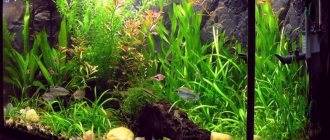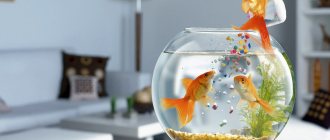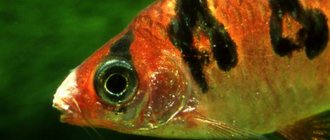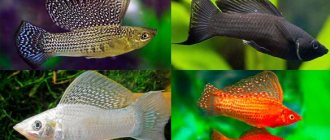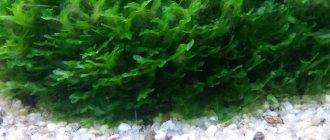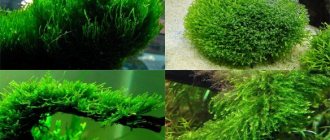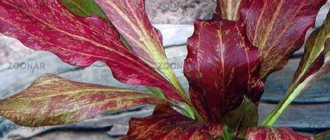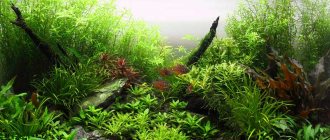Description of aquarium moss
Bryophytes belong to higher spore plants, descended from already extinct psilophytes. They can be found in many countries with warm climates - Cameroon, Bolivia, etc.
Moss beetles reproduce by spores that mature in a special organ - sporangia. Bryophytes grow in fresh water bodies and swamps. In nature, there are more than 20 thousand bryophytes.
The following types of aquarium mosses are used for aquarium decoration:
- Leafy. A numerous class, subdivided into sphagnum, brie and andrew mosses.
- Anthocerotaceae. Plants became widespread in the tropics.
- Liverworts. Bryophytes are popular due to their small size.
Moss is used not only for decorative purposes. It is used in medicine and in the construction of wooden buildings. In agriculture, plants are needed to protect the soil from erosion.
Classification
There is a large selection of mosses that can be used for aquariums . They must be selected based on the size of the tank, aquarium inhabitants and other equally important factors. Mosses can be divided into three main groups: anthocerontaceae, liverworts and phyllophytes . Now more about each of them.
There are different types of mosses
Anthocerotaceae
Quite rare plants that can be found in the tropics. Moss has lamellar leaves of green color. The plant is often used to decorate aquariums.
Anthocerotaceae
Liverworts
This group of plants is characterized by its small size and rather delicate structure. Some species have leaves and stems, which makes them very different from most bryophytes. Liverworts feel great not only in water, but also on land.
Liverworts
On a note! Some types of liverworts need to be pruned regularly. Otherwise, the lower part of the plant will rot.
Leafy
The most common group of bryophytes, of which there are more than 11 thousand species. They all have leaves and a stem, as indicated by the name of the plants. You can find deciduous plants almost everywhere where the climate is cold or temperate. Plants grow almost throughout the entire planet, except in the tropics and subtropics.
In these regions, deciduous plants still grow, but in small quantities.
TOP 11 unpretentious aquarium fish TOP 10 largest aquarium fish TOP 20 beautiful aquarium fish TOP 12 most expensive aquarium fish
Interesting facts about mosses
Scientists have found that bryophytes:
- They are among the oldest forms of life on the planet. They appeared more than 300 million years ago.
- They don't have flowers.
- They are found on all continents, but only in areas with a humid climate.
- They do not have a root system and are forced to obtain nutrients from the environment.
- Tolerates exposure to low temperatures (down to -50…-65ºС).
Cape sundew
An unpretentious carnivorous plant whose leaves contain sticky drops. Insects stick to them, after which the sundew twists the victim, digests it and opens again. The plant is suitable for those who love stability, as it does not tolerate moving well. Therefore, it is advisable not to turn it over and keep one side facing the sun. The ideal temperature for sundews in spring and summer is 20-28 degrees, and in winter 16. The predator needs to be watered regularly, the soil should always be moist. In this case, it is better to pour water into the pan, and not into the ground. If the plant’s droplets are barely noticeable or have completely disappeared, then the sundew is suffering, perhaps it lacks moisture or light.
Plant varieties
Catalog of mossfish, popular among aquarists:
- Phoenix (Fountain). The moss got its name from its branches that resemble frozen streams of water. Phoenix does not require additional power or lighting.
- Javanese bryophyte. This plant can be recognized by its flat leaves and lateral shoots. It will adapt to any environment and will not react to temperature changes.
- Riccardia chamedrifolia. Bryophyte was introduced from Taiwan. The plant loves cool water (up to +18ºС).
- Cameroon. The moss leaves give it a fern-like appearance. Cameroon does not require special conditions of detention.
- Floating riccia. This variety has neither stems nor leaves and consists only of intertwined blades. Riccia cleanses the microflora of the aquarium.
- Monosolenium tenerum. The main advantage of moss is that fish do not eat it. The plant does not respond to water quality and temperature.
- Singapore bryophyte. Suitable for small aquariums. The disadvantage is the need for frequent haircuts.
- Flame (fire). Moss is distinguished by its dark color. Flames grow on horizontal surfaces. This type of bryophyte does not respond to changes in the chemical composition of water.
- Weeping moss. The branches of the plant resemble willow twigs. It is suitable for small containers. Bryophyte gets sick due to a lack of nutrients in the water.
- Fontinalis. Moss is used only for large containers. It is unacceptable to keep fish that dig the soil in an aquarium.
- Christmas moss. Bryophyte resembles spruce. The temperature in the aquarium should not be lower than +23ºС.
- Cladophora moss. Aquarium ball made of green filamentous algae. It looks beautiful and acts as a water filter.
- Moss thong. Stringy Moss-Leptodictyum riparium is the most common and unpretentious species of moss. It only grows upward.
- Willow moss (Willow Moss) Fontinalis antipyretica is a large moss and low-maintenance moss. Leaves size up to 5mm.
- Pelia or Monosolenium tenerum. A type of liver moss. Very fragile but not demanding.
- Taiwan Moss (Taxiphyllum alternans). It has an average growth rate and is easily attached to the substrate.
- Key mosses Fontinalis hypnoides. Beautiful spring moss.
- Cameroon mosses Plagiochilaceae sp. Cameroon moss. A type of liver moss that grows slowly and looks great.
- Carpet mosses Griff Moss. Capricious, slow growing and does not like a lot of light, it reproduces easily.
- Anchor Moss. Taxiphyllum family, grows poorly and is supported by resoids.
- Brazilian mosses Brasil Moss. Not popular and little studied.
Reproduction
Reproduction of spherical mosses occurs vegetatively, and is carried out in two ways:
- mechanical;
- natural.
Algae naturally reproduce at a temperature of 26C, breaking up into separate fragments, from which new colonies are then formed. Mechanical breeding of Egagropyla occurs as follows:
- water hardness is increased by 2–3 degrees;
- a small piece is separated from the plant;
- part of the moss is transplanted into a separate container.
Egagropila has a slow growth, and during the year it increases in size by 10 mm. Complete formation of mosses takes one or two years. It will take about fifteen years to grow a large round ball with a diameter of 20 cm.
Cladophora globulus is a striking representative of the underwater plant world. Moss balls decorate the design of the aquarium, clean the aquatic environment and serve as food and shelter for the inhabitants of the reservoir. Maintaining aquarium moss is easy because it does not require complex care.
Features of care and maintenance
Mandatory measures include:
- Use of carbon dioxide. Most plant species can do without this substance. However, exotic mosses should organize its artificial supply.
- Removing new shoots. If you do not cut off young branches, they will interfere with the growth of old ones.
- Timely water replacement. It is recommended to carry out the procedure at least once a week. Add half or a quarter of the total volume of fresh water.
- Good lighting. For the health of bryophytes, light devices are installed at the rate of 0.5 W per 1 liter.
What kind of fertilizer is needed
Due to the lack of a root system, plants do not need soil fertilizers, receiving all the necessary substances from water.
Inexperienced aquarists use nitrites. However, some substances can harm plants.
At the first signs of withering or rotting, you should refuse to use the selected drug. All types of mosses react positively to copper, calcium, iron and phosphorus.
Lithops (living stones)
These plants look like pebbles, which is why they are called “living stones.” The size of the succulent does not exceed 3-4 centimeters, but during the flowering period, which occurs annually, the petals become larger than the base. If you want “living stones” to live, then you need to comply with the conditions under which other plants die: direct sunlight, infrequent watering, constant ventilation and poor permeable soil. It is important to water the plants rarely, but accurately: 1-2 times a month in warm weather, and stop moisturizing from November to March. When watering, the substrate should get wet and the water should flow out of the pot. The optimal temperature for lithops is 20-25 degrees, but even at 15 degrees the plant will not be upset.
How and where to plant aquarium moss
Bryophytes are planted on the bottom and walls of the aquarium, as well as on driftwood, stones and other decorative elements. For fixation, mosses use special organs - rhizoids. You can attach the plant using glue, thread, fishing line or mesh with small cells. The planting site is chosen depending on the type of moss grass.
Examples of plant placement:
- Phoenix and Riccardia chamedrifolia can be planted anywhere.
- Floating Riccia and Flame are attached only to horizontal surfaces.
- Java moss is often placed on the back wall of the aquarium. However, the plant is capable of attaching to any decorative element - stones, driftwood, etc.
corkscrew grass
Plant with curls. It is very unusual in its shape.
Corkscrew grass is a drought-tolerant and hardy plant. It blooms for a short time, with purple-blue flowers. Watering is needed moderate but regular. In winter, watering should be done less frequently, as this species accumulates nutrients and can survive without water for a long time.
Corkscrew or spiral grass likes rocky, clay soil. A mixture for succulents and cacti will also suit her.
Methods of fastening and binding
How to secure the moss fence:
- A bunch of the plant is wound around a piece of driftwood or stone and placed on the bottom of the aquarium. After 2-3 weeks, the branches are pruned.
- The moss is tied to the substrate with fishing line. You can also use cotton threads, which will rot over time. The branches are laid in a row so that there are no gaps.
- The plant is fixed to the mesh using superglue. The method is used to create a “carpet” at the bottom of the aquarium. Before lowering the mesh into the water, you need to make sure that the glue has hardened. Undried substance is harmful to plants and fish.
- Bryophyte is placed behind a vertically installed mesh, which can be removed after 1-2 weeks. During this time, the moss will have time to attach to the wall of the aquarium.
Living in the wild
Cladophora globulus is a type of algae that resembles moss in appearance. Other names for the plant are moss ball, lake moss, and its scientific name is Linnaeus' aegropylus. In Japan, Cladophora is known as marimo, which translates to “bouncy ball.”
In the wild, the algae grows in water bodies of Asia, Europe, Japan and Iceland. Cladophora feels great and reproduces in clean, fresh and cool waters of rivers and lakes at a depth of 2–3 meters, where the water temperature is from 18C to 24C. Thanks to the slow flow, the spherical cladophora acquires a rounded shape, rolling along the bottom.
The ability of lake moss to move allows the plant to constantly synthesize organic components, which makes the plant independent of the type of soil. In the morning and afternoon, the moss ball rests calmly at the bottom, and in the evening it floats at the surface of the water. The change in location occurs due to the accumulation of air bubbles, causing the algae to rise upward. If you get rid of them, the plant will go down again.
Cladophora globulus is not a higher aquarium plant, but a type of algae that has become popular among pond owners due to its unusual shape and ability to purify water.
Advantages and disadvantages of plants
Advantages of mosses:
- Ability to adapt to any conditions.
- Can be used in any aquarium shape.
- Easy to breed.
- Environmental friendliness. Natural decorative elements do not disturb the flora of the aquarium. Plants can serve as spawning grounds for fish.
Disadvantages depend on the variety:
- Monosolenium tenerum is distinguished by the fragility of its leaves. It is difficult to transplant from one container to another.
- Riccardia chamedrifolia needs pruning more often than other mosses.
- Cameroon is growing slowly.
- Fontinalis lives at home for no more than 12 months.
- Christmas moss requires additional lighting.
Diseases and pests
The disease may be caused by a lack of nutrients.
For example, with phosphorus deficiency, the leaves darken and red spots appear on them. Yellowing of vegetation indicates a calcium deficiency. To cure moss, you need to add the substance in which it is deficient to the water. If there is a lack of calcium, a shell is placed at the bottom of the aquarium for 3-4 weeks.
The yellow color of the water indicates the active growth of green euglena. It is safe for fish, but harmful to mosses. Filaria, or filamentous algae, is a parasite from the family of roundworms that secretes toxic substances that lead to the death of vegetation.
Spider mites are dangerous. It appears in the presence of putrefactive processes in the aquarium. The presence of the pest can be detected by brown spots on the leaves of bryophytes.
To rid the moss of a mite, it should be washed in clean water, transplanted into another container and shrimp should be added there, performing the functions of orderlies. The aquarium needs to be washed and disinfected.
Conditions for breeding
These breeding conditions are mandatory regardless of what species are used for decoration; mosses require approximately the same temperature conditions.
- The ideal temperature for maintaining the created composition of spore plants is from 20 to 25 °C.
- It is important to add nitrates and phosphates only when absolutely necessary.
- Keep the inside of the aquarium clean and periodically remove all accumulated debris.
- When growing plants, new branches must be removed, otherwise the moss that has grown on them will contribute to the death of the lower branches.
- There must be aquarium soil, as it plays an important role for all plants and inhabitants, as well as mosses, being a “natural filter” that cannot be replaced by anything.
Without soil, all processes of beneficial bacteria will be minimized, as a result of which oxygen will be deprived of processed waste products in the required quantity. Since moss feeds from environmental products, soil is also important for its existence.
You should avoid excess amounts of this “natural filter”, since in excess, nitrites, nitrates and ammonia contribute to the active growth of algae, which kills mosses.
Ways to decorate an aquarium with moss
Types of decor:
- "Persian rug". To create the composition, bryophytes such as Floating Riccia and Riccardia chamedrifolia are used.
- "Green Snake" To create it, Java moss growing in a vertical direction is used.
- "Happy New Year!". On the eve of the holiday, you can place Christmas moss in the center of the aquarium with small decorations (small rhinestones) attached to it.
- "Dense forest". The composition is created using bryophyte Flame. It is recommended to plant the plant in one part of the aquarium, leaving the other open.
Do you know what? The created compositions should be regularly looked after.
Euphorbia "Jellyfish Head"
Another plant is a succulent. This species is poisonous. Its juice may cause skin irritation. You should avoid getting it in your eyes.
It is grown as a houseplant, as well as in greenhouses and winter gardens.
Euphorbia is propagated by seeds, which sprout and grow quite quickly. The plant blooms with yellow flowers. Loves cool and dry air.
Criterias of choice
When choosing a plant, consider:
- Aquarium parameters. Cameroon, which grows up to 10 cm in length, will not be comfortable in a small container.
- Fish sizes. Pets make shelters in the branches of bryophytes. The larger the fish, the larger the moss leaves should be.
- Amount of free time and financial capabilities. If these resources are scarce, you should pay attention to unpretentious bryophytes - Flame, Floating Riccia.
- Design project. To create a particular composition, various types of mosses are used. In a large aquarium it is permissible to combine 2-3 types of plants.
Dolphin succulents
These are amazing flowering plants that can filter the air and provide oxygen. They are unpretentious and can survive for a long time without watering or fertilizing. An ideal option for those who are often away from home.
The flower got its name due to the similarity of its leaves to dolphins jumping out of the water. The longer the stem, the more the leaves resemble these beautiful sea animals.
Caring for a dolphin succulent is very easy. The main thing for a plant is bright light. But it should not be allowed to be exposed to direct rays of the sun.
Common mistakes made by new aquarists
Beginner aquarists make the following mistakes:
- Use only soft water. High hardness leads to plant death. However, in soft water, moss loses its original color and turns yellow. The recommended hardness is 6.3-6.7 pH.
- Refuse to use soil. Knowing that moss does not have roots, beginners do not place it in the aquarium so as not to worsen the condition of the water. But you shouldn’t give up the soil. It supports the vital activity of beneficial microorganisms.
- A large number of lighting devices are used. Aquarists believe that a lack of light is harmful to plants. But excess energy leads to accelerated growth of mosses. The composition may be destroyed.
The optimal water temperature in the aquarium is up to +25ºС. If the thermal regime is violated, bryophytes will stop growing or begin to rot.
Venus flytrap
If the mosquitoes in the room have sucked all your blood, and the flies have eaten all your food, but putting nets on the windows is not your format, then a Venus flytrap is the ideal solution to the problem. It is a carnivorous insectivorous plant that sometimes flowers. The sweetish smell attracts insects, but if you do not live outdoors, then you should take care of the plant’s nutrition. During the growing season, the Venus flytrap eats 2-3 live small flies, spiders or mosquitoes. Moreover, no more than one insect should be placed in each trap. You cannot feed the flower with earthworms, hard-shelled insects and gnawing bugs. In addition, if you want to share your breakfast with the plant and give it a piece of sausage, the traps will begin to rot. You can show care in another way: constantly humidify the air, use a tray with water and make sure that the substrate in the pot is moist. When autumn comes, it is worth limiting watering and emptying the water from the tray, as well as remove the plant from bright light and not feed until spring. The room temperature in winter should be 10 degrees, and in summer 20-30. It is important not to use fertilizers or water with bad water - this can kill the plant.
